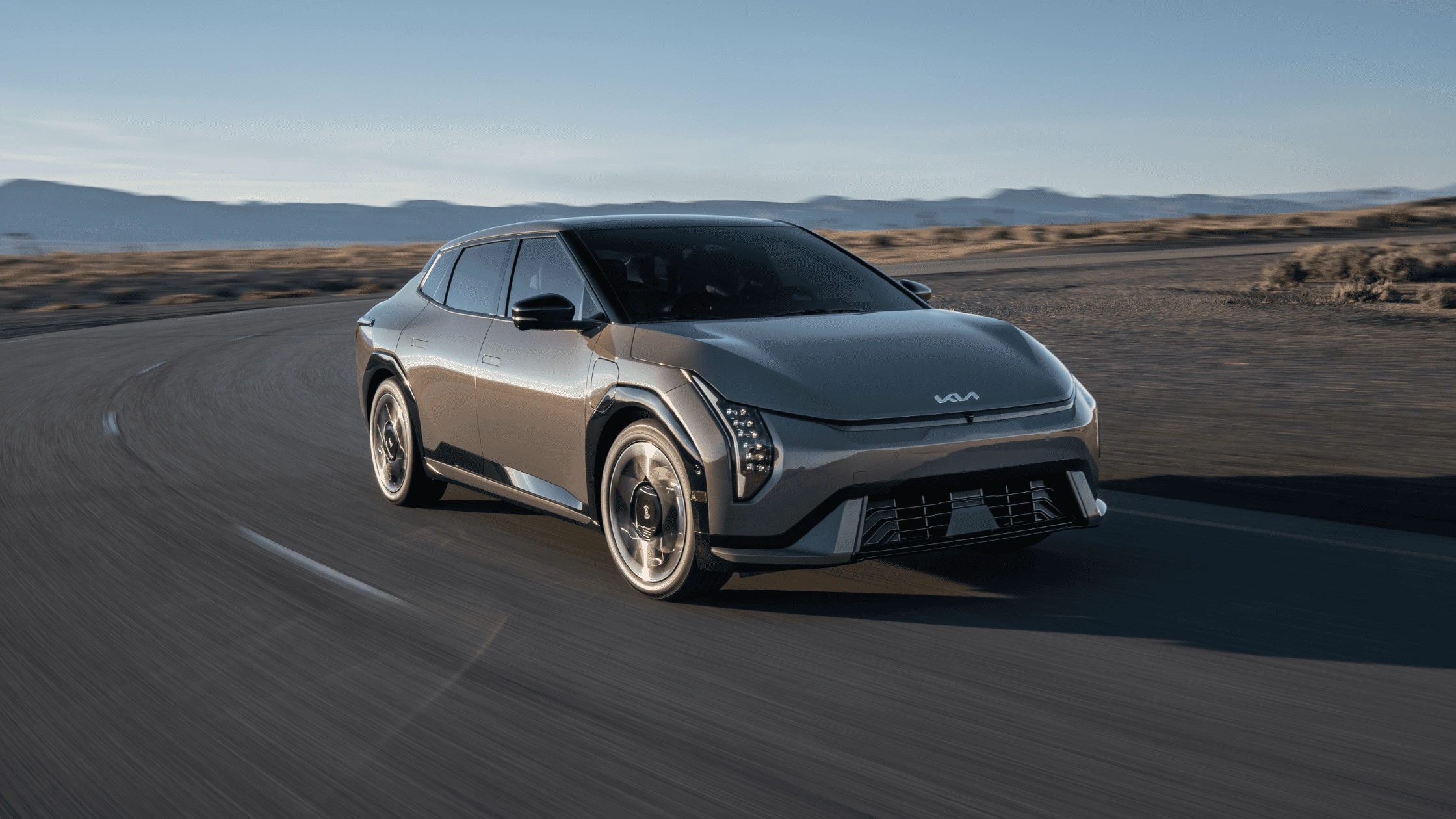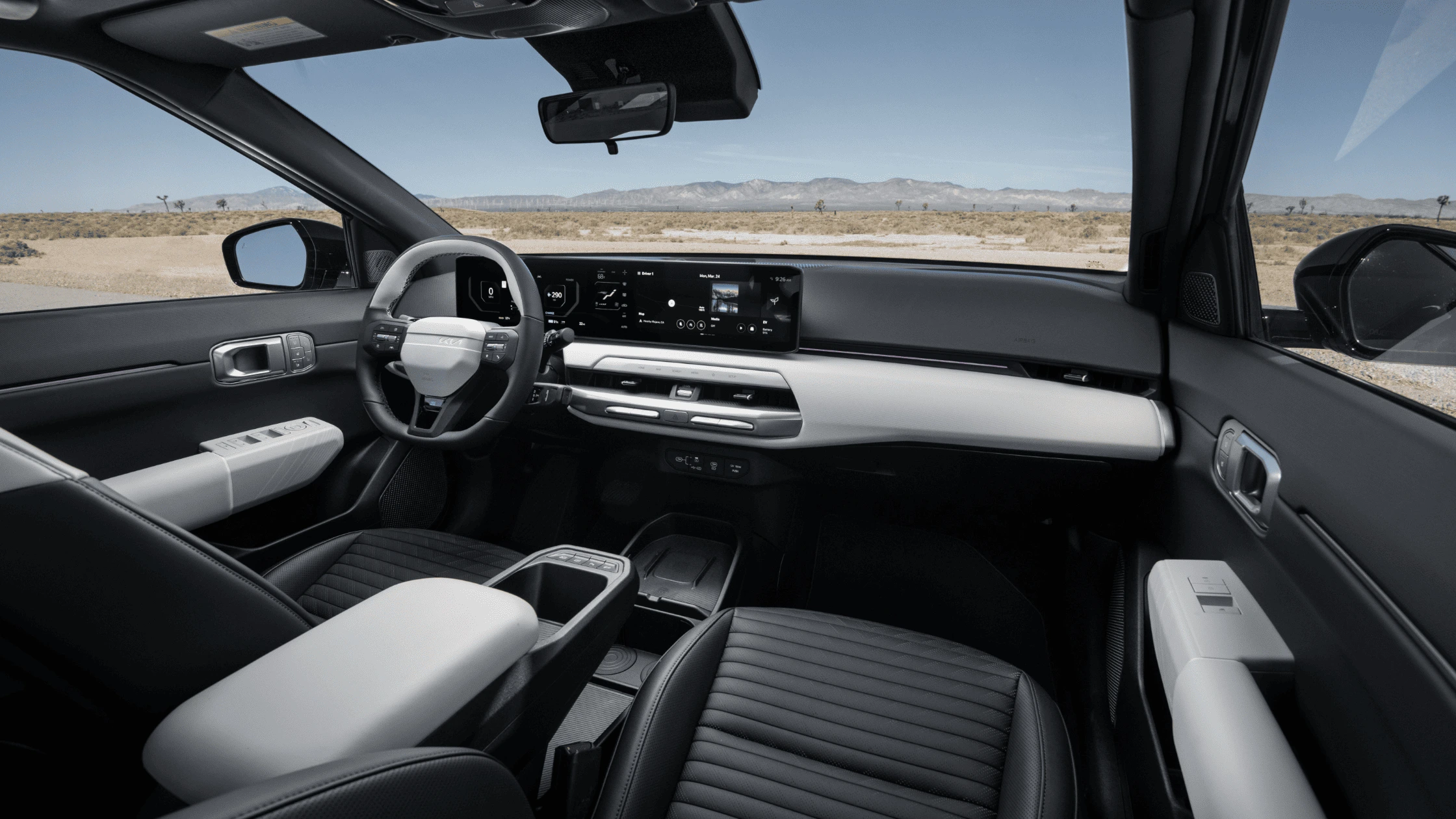
Cabin Design and Interface Technology
The 2026 Kia EV4 features a fully digital cabin environment centered around a panoramic display. This display integrates three key functional zones. A 12.3-inch digital instrument cluster provides operational readouts such as range, charge status, and driving data. A 5-inch climate control touchscreen separates core environmental functions from the infotainment system making adjustments easier without navigating menus. The 12.3-inch infotainment screen completes the interface with access to navigation, media, and vehicle settings.
Physical buttons remain on the dashboard for core controls such as volume, media power, and temperature adjustments. This decision supports driver safety by minimizing time spent on touch-based inputs. A two-spoke steering wheel houses touch-type controls to manage several display functions.

Powertrain Options and Battery Performance
The 2026 Kia EV4 is powered by a front-mounted permanent magnet synchronous motor producing 150 kW, equivalent to approximately 201 horsepower. This configuration drives the front wheels directly, eliminating the complexity and weight of an all-wheel-drive system. The powertrain supports linear acceleration with consistent torque output.
Two battery configurations are offered. The standard pack is rated at 58.3 kWh, while the extended-range version features an 81.4 kWh battery. Using the larger battery, the 2026 Kia EV4 can achieve a driving range of up to 531 kilometers on the WLTP testing cycle, which is equivalent to roughly 330 miles. This extended range enables longer use between charges without sacrificing cabin space or performance.
Disclaimer: Electric range shown is not an official EPA estimate and is based on preliminary manufacturer estimates on a vehicle with a full charge. Range will vary and depends on a number of factors, including battery age, vehicle maintenance, charging practice, weather, road/traffic conditions, ambient temperature, driving habits, options, cargo and others. Battery capacity will decrease with time and use.

Electric Global Modular Platform
The 2026 Kia EV4 uses the E-GMP architecture, optimized for electrification with a flat battery layout and front-wheel-drive configuration. Unlike earlier electric models built on converted internal combustion platforms, the 2026 Kia EV4 benefits from an architecture that was designed specifically for electric propulsion. The result is a more stable weight distribution and lower center of gravity, improving handling and interior space management.
The platform allows for a 400V electrical system, enabling compatibility with various charging networks and maintaining cost efficiency without compromising key performance goals. It also supports the model's long wheelbase, which enhances both cabin volume and aerodynamic proportions.
Refined Exterior and Aerodynamic Function
The design of the 2026 Kia EV4 follows a linear and minimalist exterior profile. Kia has integrated vertical headlamps and a prominent front-end lighting pattern known as the Star Map signature. This lighting layout is engineered not only for visual impact but also to support visibility in low-light environments through vertical integration of the LED assemblies.
At the rear, a roof-mounted spoiler contributes to aerodynamic flow, reducing drag and helping extend overall range. The exterior surfaces maintain sharp line definitions with minimal ornamentation, optimizing airflow and reducing unnecessary resistance.
Charging Infrastructure and Electrical Integration
The 2026 Kia EV4 is capable of DC fast charging. The battery can be charged from 10 to 80 percent in approximately 30 minutes under optimal conditions. This capability is essential for long-distance travel and urban recharging scenarios.
The onboard charging management system works in tandem with the vehicle's energy control unit to optimize charging speed, battery thermal management, and charge sequencing. The vehicle also includes pre-conditioning support, ensuring the battery is at the optimal temperature before high-speed charging begins.
Disclaimer: Charge time based on Kia Corporation testing with 400v 350kW DC fast charger and approximately 72 degrees Fahrenheit battery temperature. Actual charge will vary with options, driving conditions, driving habits, vehicle maintenance, charging practice, battery age, weather, temperature, and your vehicle's condition. Battery capacity will decrease with time and use. Frequent use of DC fast charging can negatively impact battery performance and durability, and Kia recommends minimizing use of DC fast charging.
Driver Assistance and Operational Safety
Although a complete list of safety systems has not been released, the 2026 Kia EV4 is expected to include the core driver assistance technologies found in other current-generation Kia models. These likely include Forward Collision Avoidance Assist and Lane Following Assist. Integration with Kia's next-generation ADAS platform ensures that vehicle safety systems are tightly coupled with the driver's actions, providing layered assistance without intrusive intervention.
Vehicle structure and passive safety have also been engineered to meet or exceed international crash standards. The E-GMP platform's rigidity and integrated battery enclosure help maintain structural integrity in side and frontal collisions.